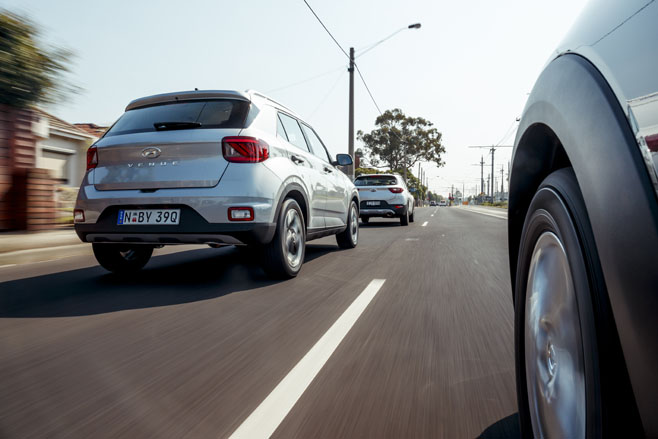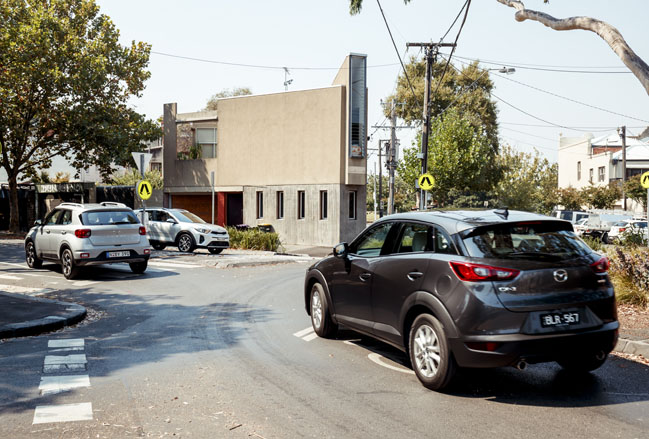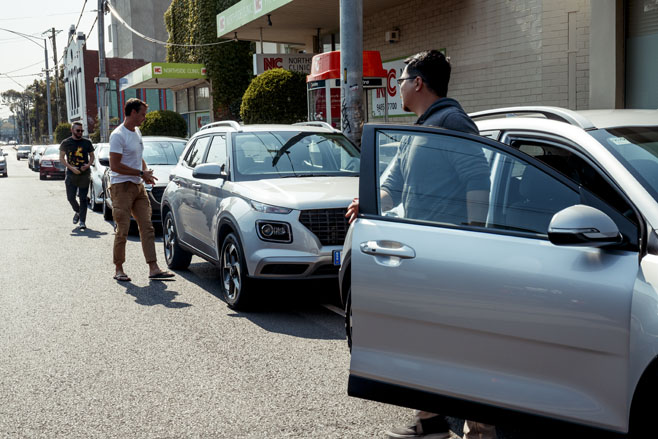Since its launch in 2015, Mazda’s CX-3 has been consistently proving itself as the mainstream compact SUV to beat and, in its whopping 15-variant line-up there’s something for everyone. Well, maybe everyone who happens to be looking for a reasonably priced, well-built, compact SUV with good road manners and a dusting of all-terrain ability.
It might be six years old now, but a series of CX-3 updates and range revisions have kept Mazda’s cash register ringing and it still offers the long list of compelling features that have stood out whenever we jump behind the wheel.
When it arrived, the newcomer did well to wade into a competitive market that was already full of popular options including the Mitsubishi ASX and gone-but-not-forgotten Holden Trax, making its mark with strong sales from the outset that continue today – Australians bought nearly 14,000 in 2020.
But if Mazda’s offering was regarded as a little late to the party in 2015, then more recent rivals from Hyundai and Kia have turned up after the glasses have been put away and the carpets shampooed. Or perhaps the younger South Korean pair is on its way to a different party where cooler people hang out …

The same shifting consumer demand that saw the rise of the baby SUV and a corresponding fall of the compact hatchback has not stopped and small cars continue to evolve. It’s not just at the smaller end of the spectrum you’ll find increasing numbers of ‘crossover’ models sneaking in with more elegant profiles, fewer off-road-focused touches and less boxy styling. This is where the new fight is emerging and where the Kia Stonic and Hyundai Venue position themselves.
While you might argue the Hyundai Venue’s arrival in 2019 was unforgivably late and turning up in early 2021 was downright rude of the Kia Stonic, the counter theory is that they are among the first to define a new funkier coupe-crossover market that everyone wants a piece of. And they surely won’t be the last.
It’s not quite that simple though. Kia’s representative may have only just rolled into Australian showrooms, but it actually launched globally nearly four years ago and it’s on an even-pegging for currency with the Venue. Nonetheless, they’re the newer models here and this battle is still about the old versus the new and whether the ageing CX-3 can put up a fight against two cooler kids.
In this heavily style-driven segment, looks are almost everything and it’s here the trio already starts to reveal their individuality. The CX-3 was praised for its unorthodox design at launch and the pinched and pulled interpretation of Mazda’s Kodo language is still unique years later but it’s clear the design team was trying to shrink one of its larger models to fit the SUV segment. Did it work? You be the judge. Either way, the Hyundai and Kia approach is different.

Rather than running their larger SUVs through a photocopier at 75 percent, the Venue and Stonic have a look that’s all of their own. The Venue is almost Japanese Kei car cubic crossed with curvy bread van and its design stands upright and confident with a cheeky face.
The Kia however, uses a third styling strategy, borrowing far more from its hatchback line-up than the SUV family. As a result, the Stonic has the most pleasing proportions of the three and is arguably the most handsome.
Dare we say it, but the Stonic does the best job of appealing to a younger audience, while the Venue’s appearance might be something for a, ahem, more senior crowd. Far less subjective though, is the tangible and objective inclusions each car offers.

All three will fit a budget of less than $27,000 excluding on-road costs and options and, regardless of which you choose, all three bring a decent amount of standard equipment. The Mazda is the most expensive but at the more affordable end of the CX-3 range costing $26,890 for the Maxx Sport. Actually, the one you see here is the pricier Maxx Sport LE which gets an eye-catching interior dressed up in multi-colour leather and synthetic suede for an extra $750 – otherwise it’s the same car throughout.
The Stonic is presented in mid-range Sport guise costing $25,990, while the Hyundai is the most affordable as the $24,640 mid-range Active.
Interestingly all three are available as a manual which chops between $1500 and $2020 out of the price but we’re testing the auto versions which will constitute the vast majority of sales.

As you might expect from its bargain basement price, the Venue omits the most gear including navigation and adaptive cruise control which is included in the other two although it wins back some points for offering the nicer seat upholstery with premium-feeling fabric and some cool white flashes. Both it and the Stonic have cloth but the Hyundai’s feels more playful and stylish which is strangely the inverse of their exteriors.
All have generously sized central touchscreens but the Mazda’s 7.0-inch version feels small compared with the 8.0-inch screen in the South Koreans, and in terms of graphics and function, the Stonic is the clear leader with cool icons and a razor-sharp display that looks cutting-edge. Along with a relatively small and primitive digital driver’s information display and incandescent lighting throughout the cabin, the Mazda can’t hide its age.
By contrast, the Kia and Hyundai have vibrant colour driver’s information screens nestled between the gauges and LED lighting, although the Venue is the only one where the technology extends to the headlights.
Go for either South Korean option and you’ll get sporty 17-inch alloy wheels while the Mazda rolls around on comparatively skateboard-like 16s.

The cost-cutting continues in the second row of the Hyundai where there are no air vents for second row occupants, nor are there any device charging options or centre arm rest, whereas you will find these in varying combinations in the other pair.
Capping off the standard equipment highlights are the emerging industry must-haves of smartphone mirroring for both Android Auto and Apple CarPlay. The Hyundai however, is one of the first cars to introduce the feature wirelessly. AEB is offered for each of our contenders.
And while value is under the spotlight, it’s also worth remembering that the Mazda is offered with a five-year warranty versus the class-leading seven-year deal offered for all Kias. The five-year warranty would ordinarily apply to a Hyundai too but, not wanting to give its sister brand a free point in the compact market, the Venue is also covered by a seven-year deal.
But back to the metal bits and, even though this comparison focuses on models that are shamelessly compact, size is still a big factor and there’s no hall-pass offered for lack of room or wasted space. Here, the newcomers do very well offering surprising volume almost everywhere you look for it.
With its tall roofline, the Venue (below) feels the biggest, offering generous occupant spaces both front and back particularly the head room all round, while there’s heaps of leg room in the second row, complemented by lots of toe space under the front seats. Out back it also benefits from a 355-litre boot.

The Stonic (below) doesn’t quite match the Venue for head room as a trade-off for the more elegant roofline but it does still accommodate four adults with a surprising degree of comfort. Five-up? That might be pushing it. It also scores well for boot space, swallowing up to 352 litres of things.

Hop into the Mazda (below) though and the cabin is immediately more confined. Quantitatively speaking, there’s a similar amount of legroom in the second row but it feels compromised by an interior that narrows toward the roofline and dives toward the rear. It’s illustrated by the diminutive boot that measures a far smaller 264 litres. The Mazda does, at least offer the most compact dimensions on the outside if maneuvering in tight spaces is a high priority.

Shopping purely from the brochure, the smart money would appear to be on the Stonic and Mazda with the most standard equipment, but get the tape measure out and it’s the Mazda that starts to lag. The balance, however, is redressed when it comes to less simplistic box-ticking.
It’s only after spending time behind the wheel and in the broad range of scenarios every compact SUV pertains to relish, that this collection of examples start to show their true characters. While the Venue is spacious and the Stonic modern, neither can beat the quality of the CX-3’s fit and finish – even if it is a little dated in design.
The latter’s driving position is the most immersive too with the snug seats holding on in all the right places compared with the flatter seats in the Korean pair. After an initial blast around built-up suburban streets it looks like the Kia and Hyundai’s locally tuned suspension and lively powertrains have the advantage over the Mazda with an eagerness to change direction and speeds, while the Mazda’s chassis feels a little under damped when negotiating imperfections in the road.
Steering feedback in the Stonic is light although the rack ratio could be faster for a car of this size and weight, the Venue does better with decent communication from the road and avoids excessive weight for easy handling at low speeds. The Mazda too, reflects its small, chuckable proportions in a well-balanced steering set up.
But it’s only as the towering high-rise cityscape and stop-start traffic is disappearing in the rear-view mirror that the CX-3 pulls ahead – literally. While the South Korean pair share numerous family resemblances, all three cars have significantly different engines.
Producing just 74kW and 133Nm the Stonic’s 1.4-litre naturally aspirated four-cylinder petrol becomes breathless as soon as the speed limits climb above 60km/h. It’ll happily rev but fails to liberate the muscle to duplicate its sprightliness about town.

The Hyundai does better in a straight-line drag and freeway speeds with a 1.6-litre to do business with but despite the extra displacement, it only manages a meager 90kW/151Nm. But, where the smaller Kia donk likes to be revved, the Venue’s four-pot petrol wont thank you with a little too much thrashy report.
Under the Mazda’s bonnet however, you’ll find another atmo four-cylinder petrol that significantly dwarfs the other two with 2.0 litres of capacity. Its peak figures of 110kW and 195Nm are fairly unremarkable for a non-turbo 2.0-litre but it makes all the difference in this context.
Tip your toe in the CX-3 and its legs feel longer with a more capable spread of power and torque across the rev range along with respectable noise, vibration and harshness levels. The figures don’t lie. While the Stonic took nearly 20 seconds to get to 400 metres from a standstill in performance testing, the Hyundai was little faster needing 18.1 seconds. The Mazda though is noticeably quicker doing the dash in 16.8s.

And it’s the same story in the benchmark 0-100km/h acceleration with the CX-3 completing the test in 9.4s while the Hyundai and Kia languished in the double figures, taking 11.3s and 13.6s respectively.
It’s logical to expect the most powerful of our three to also have the greatest thirst but that’s not always the case. While the Mazda did consume the most over our variety of suburban meandering and freeway blasts with an average of 8.2 litres per 100km, the smallest-engined Stonic was not the most frugal.
Coaxing meaningful performance from the little 1.4 meant the smallest engine spent more time near the red line than the Venue’s larger, torquier unit resulting in an average of 7.9L/100km for the Stonic and 7.5L/100km to the Venue.

In all cases, the engines are bolted to a six-speed conventional-type automatic gearbox and the Mazda’s paring also comes out on top. In the South Korean cars, the gearbox is smooth and innocuous but becomes disgruntled when asked to downshift with any urgency. That compares with a more willing nature of the Mazda’s set up.
None of the three applications offer paddle shifters for persuading more sporty gear shifts but the CX-3’s gear mapping is the most sophisticated. It’s also worth considering that while the Mazda and Hyundai both offer different driving modes, the Kia does not. In practice, neither of the systems are particularly transformative though.
Instead, the Mazda relies on an altogether more grown-up character on faster and involving roads. It isn’t the hoot that the all-wheel drive version is despite tipping the scales with fewer kilos, but it is still the most rewarding and confident when whipped – in stark contrast to the Hyundai and Kia chassis which feel choppy and fidgety the higher the speeds climb.

Jumping into an AWD CX-3 would add another $2000 to the bottom line which puts it outside the budget for this comparison, but it does highlight yet another advantage for the broader CX-3 range. For now, the Venue and Stonic are exclusively front-drive only.
Spending time in a relatively old compact SUV and a brace of newer crossovers graphically highlights how small vehicles are morphing into more hatchback-like machines. Plot the design curve through the Kia and Venue and the end point could lie in a new generation of vehicles that return to something infinitely more like cars than SUVs.
On face value, this trio of diminutive high-riders may appear to be staggeringly similar with comparable dimensions, prices and even their palette; presented here in a spectrum of monochrome. But it doesn’t take much digging to find a rift between them.
With their cheeky and contemporary designs, the Kia and Hyundai are trying to make waves and are doing a decent job of defining a new emerging segment with one foot in the SUV realm and the other in the future – or should that be the past?
Both possess a similar manner on the road and excel in the urban environment with a combination of space, handling and drivetrains that best suit a lifestyle akin to a cycle courier.

The Mazda though is simply more mature in every sense of the word. It might be older, but it continues to hit higher and punch harder than the others despite being smaller in practice and appearance. It definitely falls the shortest in space and practicality, but strides ahead when put to duties away from the confines of traffic and the metropolis.
Ultimately, the verdict comes down to the application. Both the Kia Stonic and Hyundai Venue are more at home carving up metro moguls and, combined with the more affordable price tags and disruptive styling, will appeal more to a younger or first-car audience.
But the CX-3 simply offers more to those who regularly break free of city life and are prepared to pay for it. A premium of $2250 over the Kia might not seem decisive, but in this segment money talks.
Most importantly though, these three compelling and ultimately likeable models illustrate the changing landscape in all SUV sectors. While the CX-3 is still the strongest all-rounder, it’s long in the tooth and the flow of curious coupe-crossovers that come to challenge it isn’t showing any sign of drying up.

Turbo-Free Party of Three
As the major manufacturers transition to forced induction in the name of boosted efficiency and reduced emissions, it’s increasingly difficult to find a new vehicle’s engine that still relies on natural aspiration. It’s even more unlikely, therefore, to gather together three new models and find not one of them is turbocharged. It’s not only another indication of the CX-3, Venue and Stonic’s true age, but also partly answers how manufacturers are minimising costs at the budget end of the vehicle spectrum. Only the Stonic is available as a turbo but, sitting at the top of the pack, it costs nearly $30,000.
Mazda’s SUV DNA
The CX-3 might be the oldest in this particular comparison but Mazda is not being left behind in the general evolution of the SUV. The Japanese maker has already joined the coupe-SUV-crossover curio revolution with, not one, but two models in the small vehicle market. Its MX-30 and CX-30, both dial back the SUV DNA in favour of something more closely related to the Mazda 3 hatchback, but retain a little extra ride-height and cabin headroom. Whether the design direction will filter down from the small vehicles to the compact end of the family in the CX-3’s successor remains to be seen.
Specifications
Model | Kia Stonic Sport | Hyundai Venue Active | Mazda CX-3 Maxx Sport |
Price | $26,490 (D/A)/$27,010 | $24,640 no options | $27,640/$28,304 |
Engine | inline-4cyl, dohc, 16v | inline-4cyl, dohc, 16v | inline-4cyl, dohc, 16v |
Drivetrain | front engine FWD | front engine FWD | front engine FWD |
Engine capacity | 1368cc | 1591cc | 1999cc |
Power | 74kW @ 6000 | 90kW @ 6300 | 110kW @ 6000 |
Torque | 133Nm @ 4000 | 151Nm @ 4850 | 195Nm @ 2800 |
Gearbox | 6-speed automatic | 6-speed automatic | 6-speed automatic |
Body | steel, 5 doors, 5 seats | steel, 5 doors, 5 seats | steel, 5 doors, 5 seats |
L/W/H/Wheelbase | 4140/1760/1520/2580mm | 4040/1770/1592/2520mm | 4275/1765/1545/2570mm |
Tracks | 1532/1539mm | 1535/1546mm | 1524/1521mm |
Weight | 1192kg | 1165kg | 1297kg |
Boot size | 352L | 355L | 264L |
Fuel tank size | petrol/45 litres | petrol/45 litres | petrol/48 litres |
Fuel consumption | 6.7L/100km claimed (7.9 tested) | 7.2/100km claimed (7.5 tested) | 6.3L/100km claimed (8.2 tested) |
Suspension | Front: McPherson strut Rear: coupled torsion beam | Front: McPherson strut Rear: torsion beam | Front: McPherson strut Rear: torsion beam |
Steering | electric rack and pinion | electric rack and pinion | electric rack and pinion |
Front brakes | ventilated disc (280mm) | ventilated disc (280mm) | ventilated disc (295mm) |
Rear brakes | solid disc (262mm) | solid disc (262mm) | ventilated disc (280mm) |
Tyre size | 205/55 R17 | 205/55 R17 | 215/60 R16 |
ANCAP score | five stars | five stars | five stars |
Rating | 7.5/10 | 7.0/10 | 8.0/10 |
Performance figures
km/h | Kia Stonic Sport | Hyundai Venue Active | Mazda CX-3 Maxx Sport |
10 | 0.55 | 0.53 | 0.5 |
20 | 1.49 | 1.28 | 1.19 |
30 | 2.4 | 2.09 | 1.89 |
40 | 3.35 | 2.89 | 2.6 |
50 | 4.55 | 3.9 | 3.44 |
60 | 5.85 | 5 | 4.35 |
70 | 7.4 | 6.18 | 5.39 |
80 | 9.25 | 7.79 | 6.52 |
90 | 11.37 | 9.45 | 7.82 |
100 | 13.63 | 11.29 | 9.35 |
110 | 16.5 | 13.51 | 11.04 |
120 | 20.15 | 16.4 | 12.88 |
130 | 24.92 | 19.81 | 15.47 |
140 | 31.21 | 25.17 | 18.82 |
Performance Timing | |||
0-400m | 19.16sec @ 117.155km/h | 17.95sec @ 125.13km/h | 16.78sec @ 134.29km/h |
100-0km/h | 42.82m | 41.48m | 42.60m |






